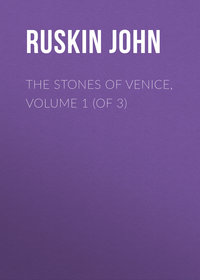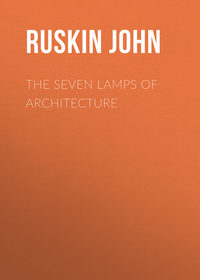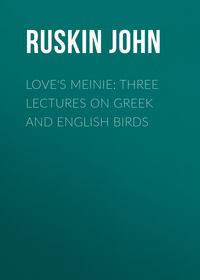 полная версия
полная версияLectures on Architecture and Painting, Delivered at Edinburgh in November 1853
1
Including York Place, and Picardy Place, but not counting any window which has moldings.
2
Oakham Castle. I have enlarged this illustration from Mr. Hudson Turner's admirable work on the domestic architecture of England.
3
Plate I. On this subject, see "The Builder," vol. xi. p. 709.
4
Sometimes of six; that is to say, they spring in pairs; only the two uppermost pairs, sometimes the three uppermost, spring so close together as to appear one cluster.
5
I am at present aware only of one tree, the tulip tree, which has an exceptional form, and which, I doubt not, every one will admit, loses much beauty in consequence. All other leaves, as far as I know, have the round or pointed arch in the form of the extremities of their foils.
6
This figure is copied from Prout.
7
I did not, at the time of the delivery of these lectures, know how many Gothic towers the worthy Glaswegians have lately built: that of St. Peter's, in particular, being a most meritorious effort.
8
There is a good abstract of the forms of the Italian campanile, by Mr. Papworth, in the Journal of the Archæological Institute, March 1850.
9
The form establishes itself afterwards in the plains, in sympathy with other Gothic conditions, as in the campanile of St. Mark's at Venice.
10
The sketch was made about ten o'clock on a September morning.
11
Among the various modes in which the architects, against whose practice my writings are directed, have endeavored to oppose them, no charge has been made more frequently than that of their self-contradiction; the fact being, that there are few people in the world who are capable of seeing the two sides of any subject, or of conceiving how the statements of its opposite aspects can possibly be reconcilable. For instance, in a recent review, though for the most part both fair and intelligent, it is remarked, on this very subject of the domestic origin of the northern Gothic, that "Mr. Ruskin is evidently possessed by a fixed idea, that the Venetian architects were devout men, and that their devotion was expressed in their buildings; while he will not allow our own cathedrals to have been built by any but worldly men, who had no thoughts of heaven, but only vague ideas of keeping out of hell, by erecting costly places of worship." If this writer had compared the two passages with the care which such a subject necessarily demands, he would have found that I was not opposing Venetian to English piety; but that in the one case I was speaking of the spirit manifested in the entire architecture of the nation, and in the other of occasional efforts of superstition as distinguished from that spirit; and, farther, that in the one case, I was speaking of decorative features, which are ordinarily the results of feelings, in the other of structural features, which are ordinarily the results of necessity or convenience. Thus it is rational and just that we should attribute the decoration of the arches of St. Mark's with scriptural mosaics to a religious sentiment; but it would be a strange absurdity to regard as an effort of piety the invention of the form of the arch itself, of which one of the earliest and most perfect instances is in the Cloaca Maxima. And thus in the case of spires and towers, it is just to ascribe to the devotion of their designers that dignity which was bestowed upon forms derived from the simplest domestic buildings; but it is ridiculous to attribute any great refinement of religious feeling, or height of religious aspiration, to those who furnished the funds for the erection of the loveliest tower in North France, by paying for permission to eat butter in Lent.
12
It has been objected to this comparison that the form of the pediment does not properly represent that of the rocks of the Trossachs. The objection is utterly futile, for there is not a single spire or pinnacle from one end of the Trossachs to the other. All their rocks are heavily rounded, and the introduction of the word "spire" is a piece of inaccuracy in description, ventured merely for the sake of the Gothic image. Farther: it has been said that if I had substituted the word "gable," it would have spoiled the line just as much as the word "pediment," though "gable" is a Gothic word. Of course it would; but why? Because "gable" is a term of vulgar domestic architecture, and therefore destructive of the tone of the heroic description; whereas "pediment" and "spire" are precisely correlative terms, being each the crowning feature in ecclesiastical edifices, and the comparison of their effects in the verse is therefore absolutely accurate, logical, and just.
13
Isa. lviii. 7.
14
Job xxiv. 6-8.
15
I mean no scandal against the present Emperor of the French, whose truth has, I believe, been as conspicuous in the late political negotiations, as his decision and prudence have been throughout the whole course of his government.
16
For farther confirmation of this statement see the Addenda at the end of this Lecture.
17
This subject is farther pursued in the Addenda at the end of this Lecture.
18
One of the most beautiful instances I know of this kind of window is in the ancient house of the Maxwells, on the estate of Sir John Maxwell of Polloc. I had not seen it when I gave this lecture, or I should have preferred it, as an example, to that of Rouen, with reference to modern possibilities of imitation.
19
A series of four examples of designs for windows was exhibited at this point of the lecture, but I have not engraved them, as they were hastily made for the purposes of momentary illustration, and are not such as I choose to publish or perpetuate.
20
The constructive value of Gothic architecture is, however, far greater than that of Romanesque, as the pointed arch is not only susceptible of an infinite variety of forms and applications to the weight to be sustained, but it possesses, in the outline given to its masonry at its perfect periods, the means of self-sustainment to a far greater degree than the round arch. I pointed out, for, I believe, the first time, the meaning and constructive value of the Gothic cusp, in page 129 of the first volume of the "Stones of Venice." That statement was first denied, and then taken advantage of, by modern architects; and considering how often it has been alleged that I have no practical knowledge of architecture, it cannot but be matter of some triumph to me, to find "The Builder," of the 21st January, 1854, describing as a new invention, the successful application to a church in Carlow of the principle which I laid down in the year 1851.
21
Thus, in speaking of Pugin's designs, I said, "Expect no cathedrals of him; but no one, at present, can design a better finial, though he will never design even a finial perfectly." But even this I said less with reference to powers of arrangement, than to materials of fancy; for many men have store enough to last them through a boss or a bracket, but not to last them through a church front.
22
Of course I use the term painting as including every mode of applying color.
23
Nothing is more notable in good Gothic than the confidence of its builders in the respect of the people for their work. A great school of architecture cannot exist when this respect cannot be calculated upon, as it would be vain to put fine sculpture within the reach of a population whose only pleasure would be in defacing it.
24
The church to Abbeville is late flamboyant, but well deserves, for the exquisite beauty of its porches, to be named even with the great works of the thirteenth century.
25
See "The Builder," for January 12, 1854.
26
Nothing appears to me much more wonderful, than the remorseless way in which the educated ignorance, even of the present day, will sweep away an ancient monument, if its preservation be not absolutely consistent with immediate convenience or economy. Putting aside all antiquarian considerations, and all artistical ones, I wish that people would only consider the steps and the weight of the following very simple argument. You allow it is wrong to waste time, that is, your own time; but then it must be still more wrong to waste other people's; for you have some right to your own time, but none to theirs. Well, then, if it is thus wrong to waste the time of the living, it must be still more wrong to waste the time of the dead; for the living can redeem their time, the dead cannot. But you waste the best of the time of the dead when you destroy the works they have left you; for to those works they gave the best of their time, intending them for immortality.
27
The character of Renaissance architecture, and the spirit which dictated its adoption, may be remembered as having been centered and symbolized in the palace of Versailles; whose site was chosen by Louis the Fourteenth, in order that from thence he might not see St. Denis, the burial-place of his family. The cost of the palace in twenty-seven years is stated in "The Builder," for March 18th, 1854, to have been £3,246,000 money of that period, equal to about seven millions now (£900,000 having been expended in the year 1686 alone). The building is thus notably illustrative of the two feelings which were stated in the "Stones of Venice," to be peculiarly characteristic of the Renaissance spirit, the Pride of State and Fear of Death. Compare the horror of Louis the Fourteenth at the sight of the tower of St. Denis, with the feeling which prompted the Scaligeri at Verona to set their tombs within fifteen feet of their palace walls.
28
An article in Fraser's Magazine, which has appeared since these sheets were sent to press, forms a solitary exception.
29
Of course I do not mean by calling these fables "paltry," to dispute their neatness, ingenuity, or moral depth; but only their want of apprehension of the extent and awfulness of the phenomena introduced. So also, in denying Homer's interest in nature, I do not mean to deny his accuracy of observation, or his power of seizing on the main points of landscape, but I deny the power of landscape over his heart, unless when closely associated with, and altogether subordinate to, some human interest.
30
This passage, respecting the book of Job, was omitted in the delivery of the Lecture, for want of time.
31
Having no memoranda of my own, taken from Giotto's landscape, I had this tree copied from an engraving; but I imagine the rude termination of the stems to be a misrepresentation. Fig. 21 is accurately copied from a MS., certainly executed between 1250 and 1270, and is more truly characteristic of the early manner.
32
When this lecture was delivered, an enlarged copy of a portion of one of these studies by Claude was set beside a similarly magnified portion of one by Turner. It was impossible, without much increasing the cost of the publication, to prepare two mezzotint engravings with the care requisite for this purpose; and the portion of the Lecture relating to these examples is therefore omitted. It is, however, in the power of every reader to procure one or more plates of each series; and to judge for himself whether the conclusion of Turner's superiority, which is assumed in the next sentence of the text, be a just one or not.
33
Not the Mr. Wells who taught drawing at Addiscombe. It appears that Turner knew two persons of the same name, and in the same profession. I am not permitted to name my authority for the anecdote; various egotistic "delicacies," even in this case, preventing useful truth from being clearly assured to the public.
34
Liberate Rolls, preserved in the Tower of London, and quoted by Mr. Turner in his History of the Domestic Architecture of England.
35
This incident is not of Orcagna's invention, it is variously represented in much earlier art. There is a curious and graphic drawing of it, circa 1300, in the MS. Arundel 83, Brit. Mus., in which the three dead persons are walking, and are met by three queens, who severally utter the sentences,
"Ich am aferd.""Lo, whet ich se?""Me thinketh hit beth develes thre."To which the dead bodies answer—
"Ich wes wel fair.""Such scheltou be.""For Godes love, be wer by me."It is curious, that though the dresses of the living persons, and the "I was well fair" of the first dead speaker, seem to mark them distinctly to be women, some longer legends below are headed "primus rex mortuus," etc.
36
Luke ii. 42, 49.
37
1 Kings iii. 5.
38
I intended this last sentence of course to apply to the thousand statues, not definitely to the one in immediate question, which, though tainted with the modern affectation, and the nearest example of it to which I could refer an Edinburgh audience, is the work of a most promising sculptor; and was indeed so far executed on the principles asserted in the text, that the Duke gave Mr. Steele a sitting on horse-back, in order that his mode of riding might be accurately represented. This, however, does not render the following remarks in the text nugatory, as it may easily be imagined that the action of the Duke, exhibiting his riding in his own grounds, would be different from his action, or inaction, when watching the course of a battle.
I must also make a most definite exception in favor of Marochetti, who seems to me a thoroughly great sculptor; and whose statue of Cœur de Lion, though, according to the principle just stated, not to be considered a historical work, is an ideal work of the highest beauty and value. Its erection in front of Westminster Hall will tend more to educate the public eye and mind with respect to art, than anything we have done in London for centuries.
April 21st, 1854.—I stop the press in order to insert the following paragraph from to-day's Times:—"The Statue of Cœur De Lion.—Yesterday morning a number of workmen were engaged in pulling down the cast which was placed in New Palace Yard of the colossal equestrian statue of Richard Cœur de Lion. Sir C. Barry was, we believe, opposed to the cast remaining there any longer, and to the putting up of the statue itself on the same site, because it did not harmonize with the building. During the day the horse and figure were removed, and before night the pedestal was demolished and taken away."
39
Or, where imagination is necessarily trusted to, by always endeavoring to conceive a fact as it really was likely to have happened, rather than as it most prettily might have happened. The various members of the school are not all equally severe in carrying out its principles, some of them trusting their memory or fancy very far; only all agreeing in the effort to make their memories so accurate as to seem like portraiture, and their fancy so probable as to seem like memory.
40
Art, its Constitution and Capacities, etc. By the Rev. Edward Young, M.A. The phrase "exceedingly young men of stubborn instincts," being twice quoted (carefully excluding the context) from my pamphlet on Pre-Raphaelitism.











